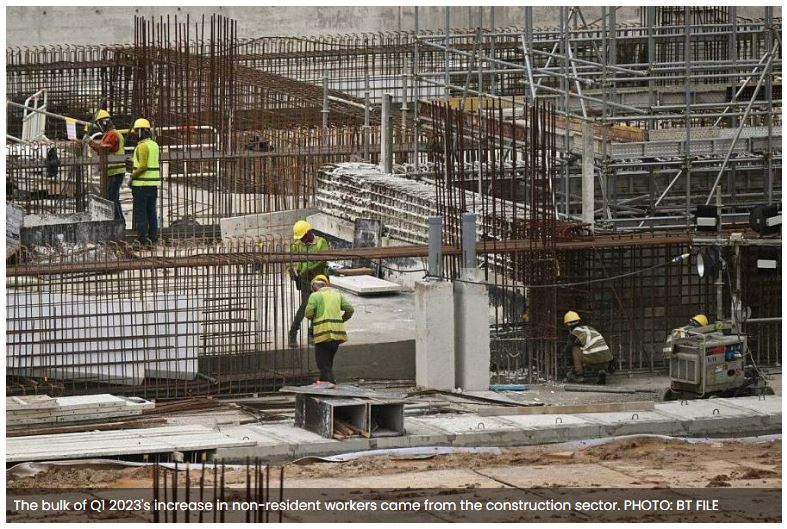Singapore employment rises 34,500 in Q1; growth moderates
SINGAPORE’S employment levels grew for the sixth consecutive quarter in Q1 2023, led by non-resident employment growth, but labour market improvements have moderated, going by advance figures from the Ministry of Manpower (MOM) on Friday (Apr 28). Retrenchments rose for the third straight quarter, even as unemployment rates stayed low.
Total employment – excluding migrant domestic workers – rose 34,500 in Q1 2023, slowing from Q4 2022, where it was up 43,500. By March 2023, the total employment level had surpassed its pre-pandemic level by 3.9 per cent.
Maybank’s regional co-head of macro research Chua Hak Bin said that employment growth has moderated to “a more sustainable pace”.
He projects that it will slow to “a more sustainable +100k” this year, after 2022’s record high full-year employment growth of 227,800.
MOM said that global economic headwinds have contributed to Singapore’s economic slowdown and will weigh on labour demand going forward, particularly for outward-oriented sectors.
Meanwhile, rising retrenchments and slowing employment growth foreshadow a softer labour market in coming months.
“Employment growth is likely to ease and remain uneven across sectors, and unemployment rates could edge up from their current lows,” it added.
As at March 2023, resident employment continued to surpass its pre-pandemic level, and non-resident employment grew above its pre-pandemic level for the first time.
Most of the growth in the first quarter was from non-residents, rising across all sectors, with the bulk coming from construction. This is even as the increase moderated for the second consecutive quarter.
Resident employment growth also eased from Q4 2022’s seasonal high. Trends in resident employment growth were mixed across industries, with largest gains in community, social and personal services (mainly in public administration and education) and financial services.
Outward-oriented or trade-related sectors such as wholesale trade, information and communications and manufacturing, on the other hand, marked declines or muted growth in resident employment, amid softening global demand conditions.
Figures for resident and non-resident employment will be released in mid-June, alongside other indicators such as job vacancies.
Unemployment rates stayed low. The overall rate slipped to 1.8 per cent in March, from 1.9 per cent in February. It also fell for residents, to 2.5 per cent from 2.7 per cent before; and for citizens, to 2.7 per cent from 2.8 per cent in the preceding month.
There were 61,500 unemployed residents in March, down from 67,100 in December. Of those unemployed in March, 54,900 were citizens.
Retrenchments, however, have risen to levels seen in 2016 and 2017. They were up to 4,000 in the Q1 2023, from 2,990 in Q4 2022, based on preliminary figures. This is equivalent to 1.9 retrenchments per 1,000 employees in Q1, against 1.4 in Q4 2022.
The increase was seen across all three broad sectors: manufacturing, mainly in electronics manufacturing; construction; and services, led by professional services and information and communications.
Business reorganisation or restructuring continued to be a top cause for retrenchments in Q1, MOM said, with industry downturn emerging as another top reason. Firms streamlined their operations in anticipation of economic slowdown, it noted.
In a Facebook post responding to Friday’s figures, National Trades Union Congress assistant secretary-general Patrick Tay said he expects continued pressures in the manufacturing sector, particularly in electronics in Q2 2023, “and likely consequent effects on related/adjacent sectors up and downstream”.
“Keeping fingers crossed and hopeful that the manufacturing sector will see some positive uptick in the latter half of the year,” he added.
MOM said that, based on forward-looking data from polls, firms remained positive about hiring, with 64.8 per cent of firms reporting plans to hire.
“However, the slowing employment growth suggests that the magnitude of increase in headcount may be more muted,” it added.
Similar to the year-ago period, more firms planned to raise wages, at 38.2 per cent in March, compared to 25.3 per cent in December 2022.
This may be intended to retain and attract talent amid stiff competition, said MOM.
But the ministry added: “Nonetheless, against the backdrop of the global economic slowdown and a more uncertain business environment, firms are likely to take a more cautious and targeted approach with salary increments.”
Chua noted: “Wage-cost pressures may cool with the pick-up in retrenchments and moderating job growth.”
Source: https://www.businesstimes.com.sg/singapore/singapore-employment-rises-34500-q1-growth-moderates


 Thailand
Thailand




